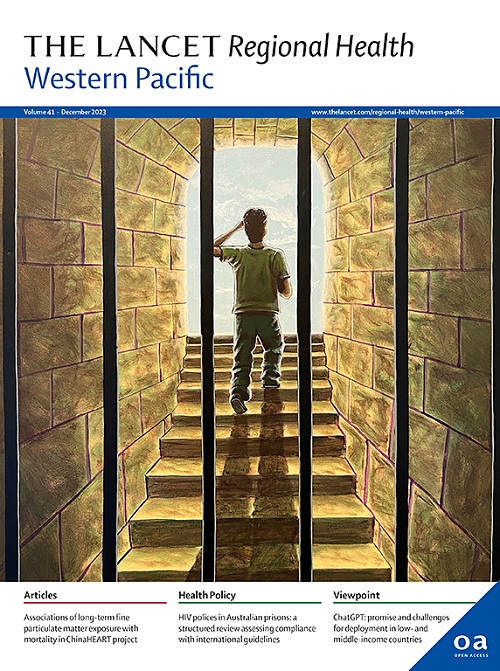Survival in Duchenne muscular dystrophy in Australia: a 50 year retrospective cohort study
IF 8.1
1区 医学
Q1 HEALTH CARE SCIENCES & SERVICES
引用次数: 0
Abstract
Background
There is limited evidence describing the changing natural history of DMD in Australia.
Methods
This retrospective cohort study collated information on clinical management and disease milestones from medical records of males with DMD attending a paediatric hospital between 1973 and 2019 and linked this to information from two adult tertiary hospitals. Data were stratified by decade of birth and Kaplan Meier analyses were conducted to describe median time to key disease milestones.
Findings
The cohort included 356 individuals with DMD with year of birth ranging from 1958 to 2014 and median (interquartile range, IQR) follow up time from diagnosis of 10.5 (4.1, 15.7) years. Use of corticosteroids, angiotensin-converting enzyme inhibitors (ACE-I), echocardiography and respiratory support increased over time. Mean age of diagnosis decreased from 6.4 years in those born before 1970 to 3.4 years in those born 2010–2019. Median (IQR) survival increased over time from 18.2 (15.2, 20.4) years in those born before 1970 to 24.0 (20.3, 27.5) years in those born between 1990 and 1999. Increased life expectancy was observed in individuals using corticosteroids, ACE-I and respiratory support.
Interpretation
Survival in individuals with DMD has increased over the last five decades, likely due to changes in clinical management. Given the increased population surviving to adulthood, there is a need to enhance clinical services and surveillance to support neuromuscular disease in Australia, especially in transitional care and adult populations.
Funding
Independent Research Grant, Pfizer Australia.
澳大利亚杜氏肌营养不良患者的生存率:一项50年回顾性队列研究
描述澳大利亚DMD自然历史变化的证据有限。方法本回顾性队列研究整理了1973年至2019年在一家儿科医院就诊的DMD男性患者的临床管理和疾病里程碑信息,并将其与两家成人三级医院的信息联系起来。数据按出生十年进行分层,Kaplan Meier分析描述到关键疾病里程碑的中位时间。该队列包括356名DMD患者,出生年份为1958年至2014年,自诊断起随访时间中位数(四分位间距,IQR)为10.5(4.1,15.7)年。皮质类固醇、血管紧张素转换酶抑制剂(ACE-I)、超声心动图和呼吸支持的使用随着时间的推移而增加。平均诊断年龄从1970年以前出生的6.4岁降至2010-2019年出生的3.4岁。随着时间的推移,中位(IQR)生存从1970年以前出生的18.2(15.2,20.4)年增加到1990年至1999年之间出生的24.0(20.3,27.5)年。在使用皮质类固醇、ACE-I和呼吸支持的个体中观察到预期寿命增加。解释:在过去的50年里,DMD患者的生存率有所提高,这可能是由于临床管理的改变。鉴于成年人口的增加,有必要加强临床服务和监测,以支持澳大利亚的神经肌肉疾病,特别是在过渡护理和成年人口中。独立研究基金,辉瑞澳大利亚。
本文章由计算机程序翻译,如有差异,请以英文原文为准。
求助全文
约1分钟内获得全文
求助全文
来源期刊

The Lancet Regional Health: Western Pacific
Medicine-Pediatrics, Perinatology and Child Health
CiteScore
8.80
自引率
2.80%
发文量
305
审稿时长
11 weeks
期刊介绍:
The Lancet Regional Health – Western Pacific, a gold open access journal, is an integral part of The Lancet's global initiative advocating for healthcare quality and access worldwide. It aims to advance clinical practice and health policy in the Western Pacific region, contributing to enhanced health outcomes. The journal publishes high-quality original research shedding light on clinical practice and health policy in the region. It also includes reviews, commentaries, and opinion pieces covering diverse regional health topics, such as infectious diseases, non-communicable diseases, child and adolescent health, maternal and reproductive health, aging health, mental health, the health workforce and systems, and health policy.
 求助内容:
求助内容: 应助结果提醒方式:
应助结果提醒方式:


